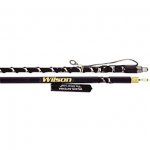Hey guys,
Thanks for all the great feedback.
So, How can I test that I haven't inadvertently created an NGP. Will the SWR skyrocket on an 8' feedline?
You can't "create" a no ground plane antenna. The antenna is either designed to operate without a ground plane or it isn't. Nothing is going to change the antenna design, unless you do something silly like start modifying it….
Also, the owner of that CB shop said I needed to buy RF cable (for CBs) in 3 foot sections. He specifically said that an 8' cable shouldn't be attached to a CB antenna. I've always understood that the shorter the cable the better to help eliminate loss in the feedline?
I'm sure that CB shop has a bridge they can sell you along with a nice plot of swamp land.
Apparently it doesn't take any knowledge at all to open a CB shop. I'd avoid that shop at all costs. The owner is absolutely clueless. Makes me wonder how someone can make a living without some basic understanding of the products they are selling.
Or, he's 100% full of crap and he's just trying to get you to purchase stuff you don't need.
Here's the issue with his line of thinking:
As Jon said, 3 feet of cable means absolutely nothing to CB. Might as well say 3 inches, 3 yards, or 3 miles.
You can use very specific lengths of coax cable to hide SWR issues. It doesn't fix anything, it just hides the issue from the CB. Not sure why CB'ers got on this kick, but it's a major disservice. If anyone tells you that you need a specific length of cable to make your CB work, and it's any more or less than the length between your CB and your antenna, walk away.
These length claims do not take into account the velocity of propagation of the cable. Again, clueless CB'ers at work. Ignore them.
The shortest reasonable length of 50Ω coaxial cable of decent quality is exactly what you should be using. "Magic" lengths are just B.S. LMR-240 is excellent cable for mobile use. Better than 99% of the CB/hobby/amateur grade stuff sold. You did good there. As for the length, if one end connects to your radio and the other end connects to the antenna, and you don't have a bunch rolled up somewhere, then it's the correct length for what you are doing. Using magic cable lengths will hide SWR issues. The antenna will show good, but it'll radiate horribly. Some CB'ers seem to think this is a good setup, but it isn't.
What you have is correct, don't change it.
Also, on the firestik 4' antenna, there's a small jumper cable that comes out of the bottom near the connector. I cut this off assuming that connecting that jumper to the antenna bracket would ground out the RF to the cable shielding. Am I correct in that assumption or should I have used that jumper?
Why?
Maybe if you explained to me why you would take a new antenna and start blindly modifying it, I could understand how to best answer that question.
No, you should not have modified it.
Wilson says: "Unique Ground Lead to Help Insure Reduced Static and Ignition Interference".
So, it's intended by the antenna manufacturer to be grounded.
Explain to me why you chose to cut that off again? I'm not following your logic.
Actually, I'm mistaken, it's not a firestik, it's a Wilson 305-4FD. I guess, looking back and reading the specifications of the antenna it looks like that jumper is for static reduction and not for grounding the RF to the shielding...I may have answered my own question.
Yep, always a good idea to read the directions first.
But that still doesn't explain why 3' sections is the 'rule'
Because the CB shop owner doesn't have a clue what he's selling. His "rule" is to BS customers so they'll buy stuff they don't need. Probably how he stays in business.
Lemme guess, all the local CB'ers claim the guys a genius?


